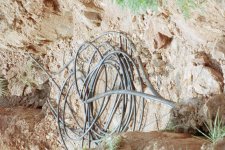eepete
Platinum Member
maybar, the answer to your question probably lies in the thermostat. I have geothermal heat pumps. The thermostats can be set to a mode where they call for heat if it's too cold, and cool if it's too hot. So you can specify a range of temperature.
One think I like about the geothermal is no outside unit to make noise. All the comments thus far are good. I'm working on getting KW hour data on energy use. If anyone use the "REScheck" software program thats on line at the U.S. DOE site, that number might be a good way to compare insulation quality of a house. Our number was 900 if I remember correctly. To get an energy star rating, I think that number has to be below 1200. Score is like golf, low is good.
We have horizontal ground loop (black PE pipes buried 4-6 feet deep). Our trenches came out about 5 percent short due to bouncing measuring wheel, so if you go this route add 5 percent to what you measure out. This error left us with some 3/4 pipe coiled up in the manifold pit (see picture).
We have a 3 ton two speed compressor unit with 2000 feet of pipe, and a 5 ton and 3 ton that share another ground loop with 4800 feet of pipe. It's been a hot summer, and the water temperature coming out of the ground is about 76 degrees. Last winter, which was a bit colder than normal for here in North Carolina, the loop got down to 50 degrees. If I were installing again, I might increase the loop lengths by 25 percent more even if it did involve yet another "discussion" with a tradesman.
We tried a pond loop, and I would not advise it. The pond water got down to a bit below 40 degrees, and that directly impacted how long it took to heat things up in the winter. All other conditions equal heating up a room from 68 degrees with the pond we had 78 degree air, with the ground loops we had 90 degree air. Big difference in how long the unit ran (and hence the cost).
From these ground temps, you can see why a well insulated house is important. You don't want to run out of ground heat or sink capacity. You can also see where the efficiency is (from a hand waving view). When we are cooling, it's like running an air conditioner when it's 76 degrees out. When we are heating, it's like running a heat pump when it's 50 degrees out.
Dual speed compressor are a must. The only time our units kick into the full power/speed mode is when we change the set temperature by more than a degree or so. For humidity control when cooling, the low speed compressor is what makes it all work.
Anyway, all good comments thus far. Like many things house related, where you are makes a big difference due to climate and (for geothermal) soil conditions.
Pete
One think I like about the geothermal is no outside unit to make noise. All the comments thus far are good. I'm working on getting KW hour data on energy use. If anyone use the "REScheck" software program thats on line at the U.S. DOE site, that number might be a good way to compare insulation quality of a house. Our number was 900 if I remember correctly. To get an energy star rating, I think that number has to be below 1200. Score is like golf, low is good.
We have horizontal ground loop (black PE pipes buried 4-6 feet deep). Our trenches came out about 5 percent short due to bouncing measuring wheel, so if you go this route add 5 percent to what you measure out. This error left us with some 3/4 pipe coiled up in the manifold pit (see picture).
We have a 3 ton two speed compressor unit with 2000 feet of pipe, and a 5 ton and 3 ton that share another ground loop with 4800 feet of pipe. It's been a hot summer, and the water temperature coming out of the ground is about 76 degrees. Last winter, which was a bit colder than normal for here in North Carolina, the loop got down to 50 degrees. If I were installing again, I might increase the loop lengths by 25 percent more even if it did involve yet another "discussion" with a tradesman.
We tried a pond loop, and I would not advise it. The pond water got down to a bit below 40 degrees, and that directly impacted how long it took to heat things up in the winter. All other conditions equal heating up a room from 68 degrees with the pond we had 78 degree air, with the ground loops we had 90 degree air. Big difference in how long the unit ran (and hence the cost).
From these ground temps, you can see why a well insulated house is important. You don't want to run out of ground heat or sink capacity. You can also see where the efficiency is (from a hand waving view). When we are cooling, it's like running an air conditioner when it's 76 degrees out. When we are heating, it's like running a heat pump when it's 50 degrees out.
Dual speed compressor are a must. The only time our units kick into the full power/speed mode is when we change the set temperature by more than a degree or so. For humidity control when cooling, the low speed compressor is what makes it all work.
Anyway, all good comments thus far. Like many things house related, where you are makes a big difference due to climate and (for geothermal) soil conditions.
Pete

